Change Page: 1234 > | Showing page 1 of 4, messages 1 to 20 of 66 - powered by ASPPlayground.NET Forum Trial Version
Author
|
Message

|
 Breeding Journal, Species: Doryrhamphus excisus
Wednesday, August 31, 2011 3:59 PM
Breeding Journal, Species: Doryrhamphus excisus
Wednesday, August 31, 2011 3:59 PM
( permalink)
Breeding Journal DataSheet
This first post should be updated regularly to include new information as events take place or changes are made to your system General Species: Doryrhamphus excisus (Bluestripe pipefish) Social Structure: One mated pair Size of Individuals: 2-3" Age of Individuals: Unknown. I've had them for a little over a year. Date added to Tank: A little over a year ago. The earliest date I have documented is 8/8/2010. Broodstock Tank Details Size of Tank: 210 Gallons Substrate Details: Aragonite sand Filtration Details: Skimmer, chaeto in sump. Water Changes: Varies with my enthusiasm for doing it. I've been trying to do 5% daily recently. Water Temperature: Diurnal range from 78-82F Lighting: 4 x 39 watt T5 actinics + 3 x 250 watt MH. Lighting Cycle: Actinics are on 12 hours a day. MH are on 6 hours a day. Other Tank Inhabitants: Many other fish and inverts. 1 Yellow Tang, 1 Flame Hawkfish, 1 Coral Beauty Angel, 1 Clown Goby, 2 Ocellaris clowns, 2 RBTAs, 1 Coral Banded Shrimp, 2 Cleaner Shrimp, several Peppermint Shrimp, assorted snails and hermit crabs, various soft corals, lots of live rock arranged to provide as many caves and hiding places as possible, a bunch of halimeda I'd like to get rid of, some aiptasia..... you get the idea. Broodstock Feeding Details Food Types: Various frozen meaty foods, which they take freely. They also hunt copepods, and probably the mysids in the tank, too, all day long. Feeding Schedule: 2-3 times a day. Spawning Details Date of First Spawn: 8/8/2010 or thereabouts. Spawn Time of Day: Not seen, I've heard it is in the morning, right after they wake up. Dates of Consecutive Spawns: Roughly every 4-6 days or so. He is perpetually pregnant. Courtship Details: They seem to always hang out together. Egg Size: I've never seen them well enough to determine size. They are hidden in the male's skin flaps on his abdomen. Egg Color: Orange Egg Count: Perhaps 50 or so Hatch Details Hatch Date: 9/1/2011. After the 9/1/2011 hatch, there was another hatch on 9/5/2011. They have hatched ever 4 days since then, quite reliably. Hatch Time of Day: Evening, after lights out, about 10:00 PM # Days after Spawn: Appx. 4 Larvae Description: Like tiny cute copies of the parents, appx. 3/16" long. Larval Tank Details Temperature: Ambient room temp, low 70s F Size of Larval Tank: Initially, a 2 gallon fishbowl kriesel. Substrate Details: None Other Tank Decor: None Filtration Details: Live phytoplankton (Isochrysis and Thalassiosira). Lighting: 13 watt fluorescent aquarium strip light placed over the fishbowl, later changed to a 6500K CFL in a clamp-on reflector fixture. Lighting Cycle: Appx. 18 H on / 6 H off. Water Changes: Small and frequent. As I turkey baste out waste, I top off the fishbowl with clean salt water. Larval Feeding Details Food Types: Rotifers, Acartia tonsa, Apocyclops pamanemsis, Parvocalanus crassiostris, hermit crab larvae. Feeding Schedule: Just keep food items of all types present at all times. Most of them reproduce by themselves, once the tank is seeded and fed live phyto. Metamorphosis/Settlement Date of Settlement Start: 9/17/2011 Days after Hatch: 12 Date of Settlement End: 9/17/2011 Description of Fry: Small versions of parents, more orange coloration than the larvae. More opaque than the larvae. Still don't have adult coloration yet.
Grow-Out Tank Details Temperature: 74 F Size of Grow-Out Tank: 5.5 Gallons Substrate Details: None Other Tank Decor: A few Black ABS Pipes Filtration Details: Small HOB filter Lighting: Fluorescent strip light Lighting Cycle: Manual, appx. 16 H on / 8 H off Water Changes: Irregular, weekly. Size at Transfer: Various -- from 1/2" to 1" Age at Transfer: Various -- from 2 - 3 weeks or so. Grow-Out Feeding Details Food Types: Copepods of various species (mostly Apocyclops and Tigriopus), Moina, Frozen BBS, Frozen Cyclops Feeding Schedule: Several times a day. Fewer times when trying to wean onto the frozen foods. Additional Information We originally got two males and two females. They were placed into a 29 gallon species tank, originally. They seemed to be two pairs that got along nicely together. One of the males died almost immediately (within just a couple of days). As soon as that male died, the larger female became very aggressive toward the lone female. I moved the lone female to the 210 gallon tank to protect her. The pair in the 29 gallon started mating within a few weeks. After a couple of months, the female in the 29 gallon then died. I put the lone male into the 210, and the female who had been living in the 210 and the newly introduced male found each other within about 5 minutes, and have been inseparable ever since. They have been mating continuously for the last several months. I did not record the dates of all of the events just described, but I know that these two have been together at least since the first of this year. I've not yet tried to raise their fry, but am going to attempt do so now. Miscellaneous Information:
<message edited by JimWelsh on Thursday, December 8, 2011 10:34 AM>
|
|
|
 Re:Breeding Journal, Species: Doryrhamphus excisus
Sunday, September 4, 2011 9:09 PM
Re:Breeding Journal, Species: Doryrhamphus excisus
Sunday, September 4, 2011 9:09 PM
( permalink)
Here are some pictures of the parents. I'll try to get better ones and post them later. The male is really hard to get pictures of, as he is very shy. In the 210 display where they live, there is quite a bit of live rock, and it is arranged so as to make as many caves and hiding places as possible, which the male exploits adeptly. EDIT: I don't know why the images didn't upload the first time. I hope they work this time. Here is the male holding eggs back in August, 2010:  Here is the female, taken Friday, 9-2-2011: 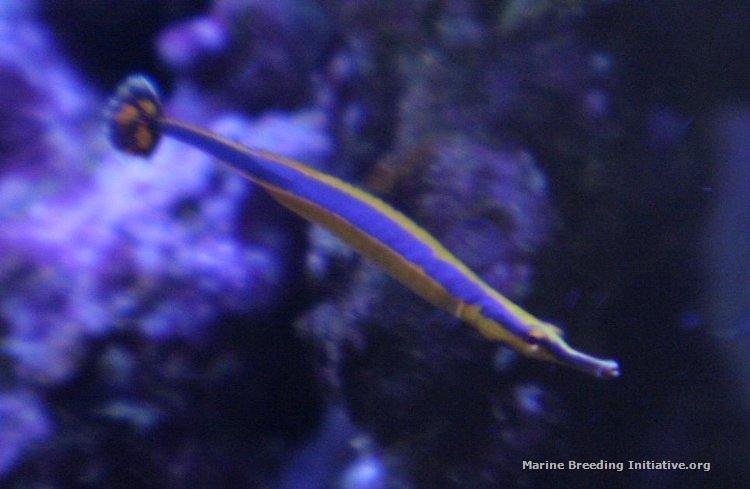 Here is the pair of them together, but a very poor quality image: 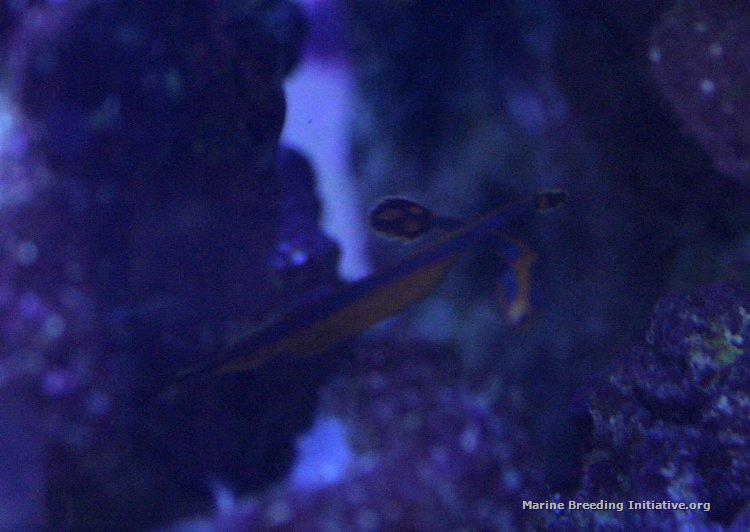
|
|
|
 Re:Breeding Journal, Species: Doryrhamphus excisus
Sunday, September 4, 2011 9:32 PM
Re:Breeding Journal, Species: Doryrhamphus excisus
Sunday, September 4, 2011 9:32 PM
( permalink)
|
|
|
 Re:Breeding Journal, Species: Doryrhamphus excisus
Monday, September 5, 2011 6:51 AM
Re:Breeding Journal, Species: Doryrhamphus excisus
Monday, September 5, 2011 6:51 AM
( permalink)
So cute! Go Jim, go!
|
|
|
 Re:Breeding Journal, Species: Doryrhamphus excisus
Tuesday, September 6, 2011 9:12 AM
Re:Breeding Journal, Species: Doryrhamphus excisus
Tuesday, September 6, 2011 9:12 AM
( permalink)
He released again last night, on 9/5/2011, just four days after the last hatch! Again, I set up Chad's snagger. Again, there are something like at least 50 fry. Pipefish fry are a lot harder to count than seahorse fry -- they are more translucent, and hard to see, and are a lot "jumpier", and don't hold still as much as seahorse fry do. Plus, you can collect seahorse fry in the daylight, and count as you collect them. Pipefish parents are fry eaters, and you have to get the pipefish fry out of the tank under cover of darkness. I did notice a couple of really ugly, mutant pipefish fry in this particular batch, though. Thicker than normal, with no snout to speak of. I got some blurry images of them this morning. There are at least two, possibly more of these ugly pipefish in this batch  : 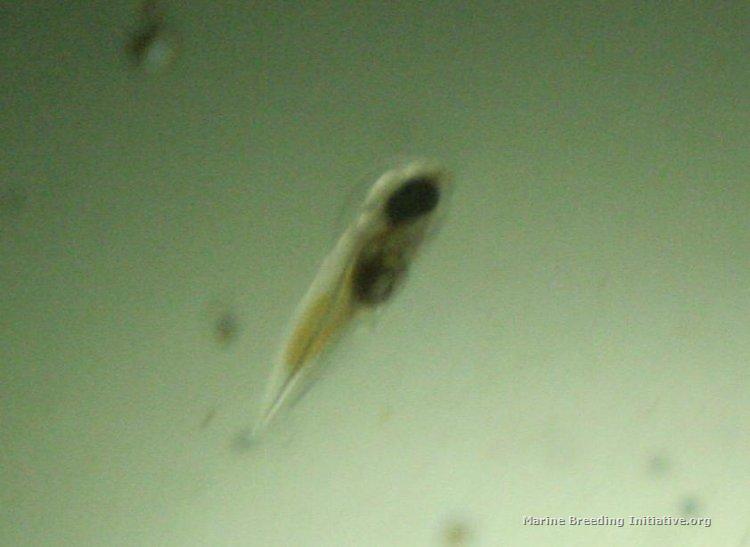 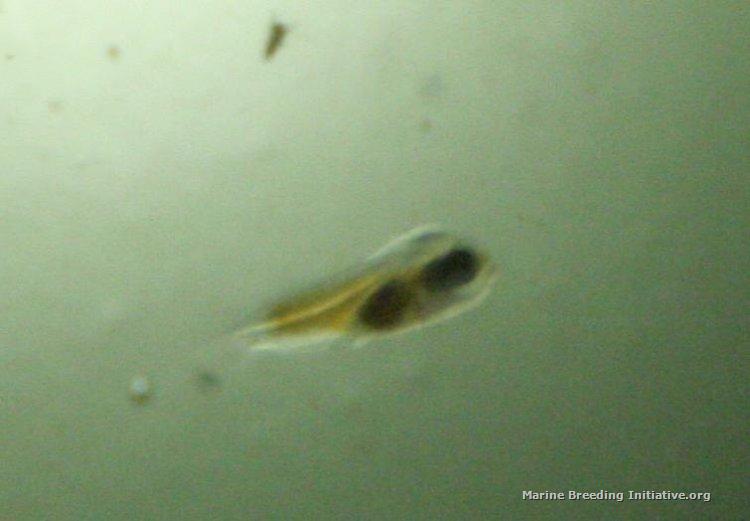 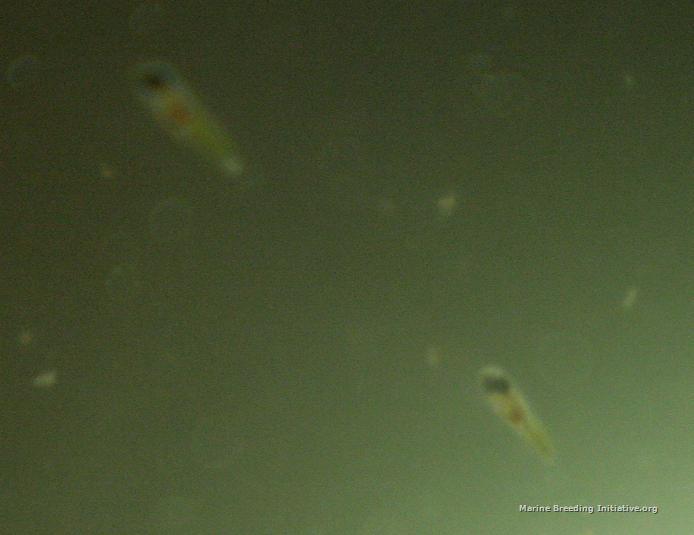
|
|
|
 Re:Breeding Journal, Species: Doryrhamphus excisus
Tuesday, September 6, 2011 6:26 PM
Re:Breeding Journal, Species: Doryrhamphus excisus
Tuesday, September 6, 2011 6:26 PM
( permalink)
Like the ugly duckling? Those aren't pipefish. You got clownfish in that broodstock tank...
|
|
|
 Re:Breeding Journal, Species: Doryrhamphus excisus
Tuesday, September 6, 2011 6:28 PM
Re:Breeding Journal, Species: Doryrhamphus excisus
Tuesday, September 6, 2011 6:28 PM
( permalink)
 Originally Posted by KathyL
Like the ugly duckling? Those aren't pipefish. You got clownfish in that broodstock tank...
I was gonna say...
|
|
|
 Re:Breeding Journal, Species: Doryrhamphus excisus
Tuesday, September 6, 2011 6:42 PM
Re:Breeding Journal, Species: Doryrhamphus excisus
Tuesday, September 6, 2011 6:42 PM
( permalink)
LOL! I've been waiting all day for somebody to catch on and comment! You win the prize, Kathy. Looking at them now that I'm home for work, there are a few in there, hard to tell how many, but probably 5-10. I guess I totally missed out on a nest of occelaris eggs. I know those clown had spawned a week or two ago, but hadn't seen any new eggs. They didn't nest in the same spot, that's for sure, since I've been checking that spot. Now I get to try to co-culture pipes and clowns!
|
|
|
 Re:Breeding Journal, Species: Doryrhamphus excisus
Tuesday, September 6, 2011 7:06 PM
Re:Breeding Journal, Species: Doryrhamphus excisus
Tuesday, September 6, 2011 7:06 PM
( permalink)
Yeah, those are hideous. Congrats on the clown hatch.
--Andy, the bucket man. "Not to know the mandolin is to argue oneself unknown...." --Clara Lanza, 1886
|
|
|
 Re:Breeding Journal, Species: Doryrhamphus excisus
Tuesday, September 6, 2011 7:38 PM
Re:Breeding Journal, Species: Doryrhamphus excisus
Tuesday, September 6, 2011 7:38 PM
( permalink)
I'm always the one to say that the emperor has no clothes….Glad I wasn't being stupid.
|
|
|
 Re:Breeding Journal, Species: Doryrhamphus excisus
Wednesday, September 7, 2011 12:40 PM
Re:Breeding Journal, Species: Doryrhamphus excisus
Wednesday, September 7, 2011 12:40 PM
( permalink)
Congrats Jim! On the pipefish and 'mutant' fry. LOL!
The pipefish are very pretty!
|
|
|
 Re:Breeding Journal, Species: Doryrhamphus excisus
Thursday, September 22, 2011 9:41 PM
Re:Breeding Journal, Species: Doryrhamphus excisus
Thursday, September 22, 2011 9:41 PM
( permalink)
|
|
|
 Re:Breeding Journal, Species: Doryrhamphus excisus
Thursday, September 22, 2011 10:37 PM
Re:Breeding Journal, Species: Doryrhamphus excisus
Thursday, September 22, 2011 10:37 PM
( permalink)
The oldest fry I have now is 17 days old, hatched 9/5/2011. Pics below. There were 0 survivors of the first batch hatched 9/1/2011. I had 6 of them that got to 6 days, and then too abupt a water change killed them. I have only this one left from the 9/5/2011 hatch. There are two alive from the 9/9/2011 hatch. The 9/13/2011 hatch was few in number, and they all looked weak, and I chose not to attempt to raise them. The 9/17/2011 hatch has probably about 20 or so left alive now, at day 5, and I'm also raising yesterday's hatch. Each hatch is approximately 30-50 fry. I've been using goldfish bowl kriesels (full to the top, with a rigid airline halfway down one side, with very gentle bubbling from a rigid airline with no stone), with live phyto green water (a mix of Isochrysis and Thalassiosira), rotifers, Apocyclops, and Acartia. I've been having a problem with the combination of live phyto + nitrates in parent tank water + ammonia produced by the fry + light + the aeration by the airline = lots of Oxygen, making lots of little bubbles by the end of the day. The earlier batches had very high mortality on days 1 and 2 from the bubbles clinging to the fry, making them float and die due to starvation. The younger batches have had less early mortality, because I have used less live phyto and less light, reducing the bubble problem. Time will tell whether this will result in more of them surviving to 60 DPS. Here are a couple of pictures of the 17 day old fry taken a few minutes ago: 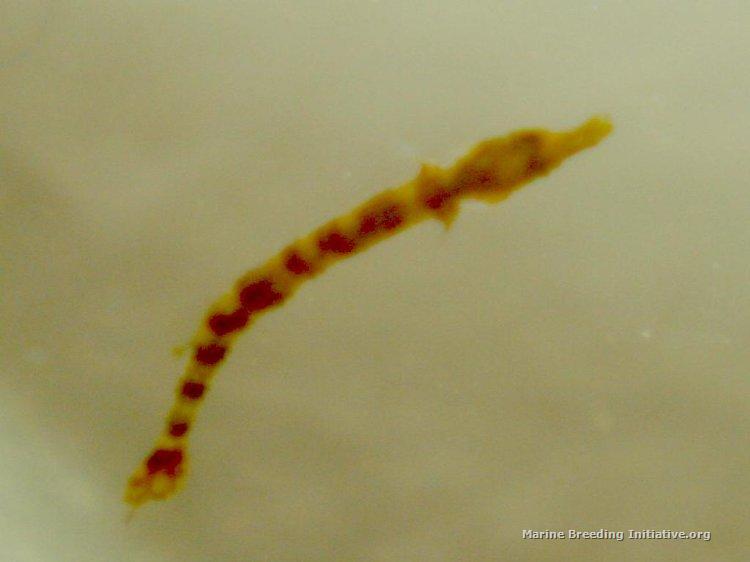 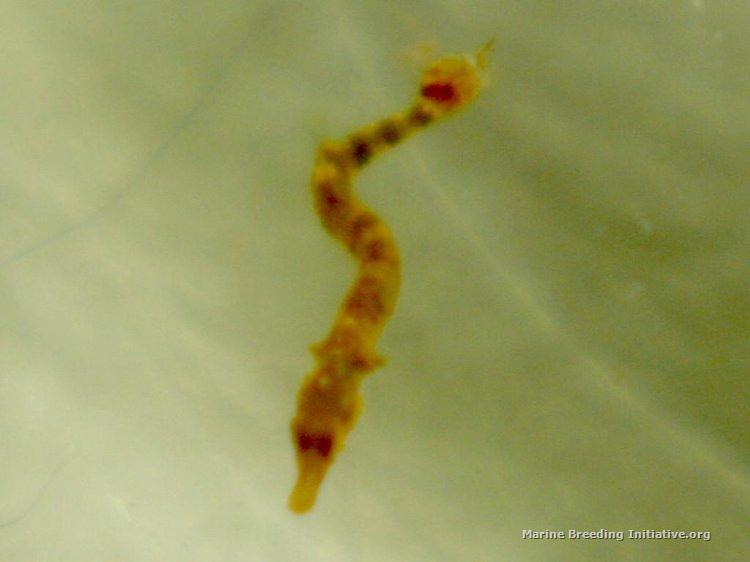
|
|
|
 Re:Breeding Journal, Species: Doryrhamphus excisus
Thursday, September 22, 2011 10:40 PM
Re:Breeding Journal, Species: Doryrhamphus excisus
Thursday, September 22, 2011 10:40 PM
( permalink)
beautiful!
|
|
|
 Re:Breeding Journal, Species: Doryrhamphus excisus
Friday, September 23, 2011 7:18 AM
Re:Breeding Journal, Species: Doryrhamphus excisus
Friday, September 23, 2011 7:18 AM
( permalink)
+2. Congratulations, Jim!
--Andy, the bucket man. "Not to know the mandolin is to argue oneself unknown...." --Clara Lanza, 1886
|
|
|
 Re:Breeding Journal, Species: Doryrhamphus excisus
Friday, September 30, 2011 8:46 PM
Re:Breeding Journal, Species: Doryrhamphus excisus
Friday, September 30, 2011 8:46 PM
( permalink)
I wonder what role, if any, the low temperatures may be playing in your survival rates? Nice first fish through! I'm thinking we have less than 60 days to go now? 
|
|
|
 Re:Breeding Journal, Species: Doryrhamphus excisus
Friday, September 30, 2011 8:58 PM
Re:Breeding Journal, Species: Doryrhamphus excisus
Friday, September 30, 2011 8:58 PM
( permalink)
Thanks, Matt for the food for thought. I'll take that into consideration. If I get that one to November 17th, I'll have 60DPS!
By the way, I've had notably better success with one subsequent batch. Appx. 15-20 fry from that batch still alive at day 13 now.
|
|
|
 Re:Breeding Journal, Species: Doryrhamphus excisus
Friday, September 30, 2011 9:00 PM
Re:Breeding Journal, Species: Doryrhamphus excisus
Friday, September 30, 2011 9:00 PM
( permalink)
Why no reporting on that batch Jim? Let's learn about what you're doing differently! Keep us in the loop!
|
|
|
 Re:Breeding Journal, Species: Doryrhamphus excisus
Friday, September 30, 2011 9:13 PM
Re:Breeding Journal, Species: Doryrhamphus excisus
Friday, September 30, 2011 9:13 PM
( permalink)
You are right, Matt. I alluded to the change in post #13 in this thread, but have not followed up.
It appears that the greatest mortality with these is in just the first couple of days. While there are many benefits to the live phyto approach, one serious downside is that if I use too much phyto and too much light, I end up with too much DO in the water, which manifests as tiny bubbles on many of the fry, which causes them to float to the surface and die. The greatest success I have had so far is with one batch, where I used a more moderate amount of live phyto, and no direct lighting, but only indirect lighting from the south-facing windows with the translucent white blinds for the first 4 days or so. I have somewhere around 15-20 fry still alive from that batch. The next batch, hatched 4 days later, was treated similarly, and was looking really good, except in this case, the rotifers bloomed on about day 4, and I had massive dieoff, with only 1 fry remaining, I suspect from ammonia from the rotifers eating all the live phyto, thus killing off my ammonia control, and creating more ammonia in the process. I'm still working this all out, and the last two batches of fry have been small and weak. I don't know what is going on with the broodstock -- if they are petering out, or what. Time will tell.
|
|
|
 Re:Breeding Journal, Species: Doryrhamphus excisus
Friday, October 7, 2011 1:40 AM
Re:Breeding Journal, Species: Doryrhamphus excisus
Friday, October 7, 2011 1:40 AM
( permalink)
OK, I've taken some notes, in addition to the information listed above, on each batch, and here is a summary of each:
Hatch 9/1/2011: 6 made it to 6 days before operator error killed them (too large a water change too quickly).
Hatch 9/5/2011: Only 1 has survived. Bubbles from too much phyto + too much light killed most in the first couple of days.
Hatch 9/9/2011: Only 2 have survived. Primarily, the same phyto+light bubble problem, plus competition from numerous peppermint shrimp larvae that hatched the same night did most of these in.
Hatch 9/13/2011: Very few, very weak fry. I chose not to raise them.
Hatch 9/17.2011: Dialed back the light on the fishbowl for the first few days. Basically, very indirect ambient light only. Much better success. About 20 still alive at day 4, and about 15 still alive now.
Hatch 9/21/2011: Same treatment as the 9/17 batch, and more or less the same results.
Hatch 9/25/2011: These were doing well until about day 3 when the rotifers somehow took off and bloomed, and for some reason, this killed off all but 1 of these. I still have only the 1 from this batch.
Hatch 9/29/2011: Another very weak batch. I only snagged about 10 or so, and only 4 were alive the first morning. These have been fed ONLY Parvocalanus (Chad from Reed wanted to know if fish were eating the Parvo, so I indulged him). So far, 3 of the 4 are alive and well on day 7.
Hatch 10/3/2011: A nice, large, normal batch. These have also been fed only Parvocalanus. It is only day 3, and so it is too early to tell, but preliminary results are very encouraging. I still have > 20 still alive today.
The technique of keeping a moderately dense culture of live copepods in moderate greenwater made up of live phyto with subdued light for the first few (4 or so) days in a 2-gallon goldfish bowl kriesel seems to be working very well. To me, the keys seem to be 1) Keep copepods always present in decent numbers, 2) Keep the water lightly to moderately tinted with live phyto -- never clear, and never too dense, and 3) Keep some light on the container, but not too much too close -- if you see small bubbles forming on the upper surfaces of the glass fishbowl sides, you have too much light, and need to back it off, or you will lose fry.
I think that a mixture of copepod species is probably preferable to a monoculture, but I must concede that these two recent batches being fed only Parvocalanus are doing very well!
|
|
|
|